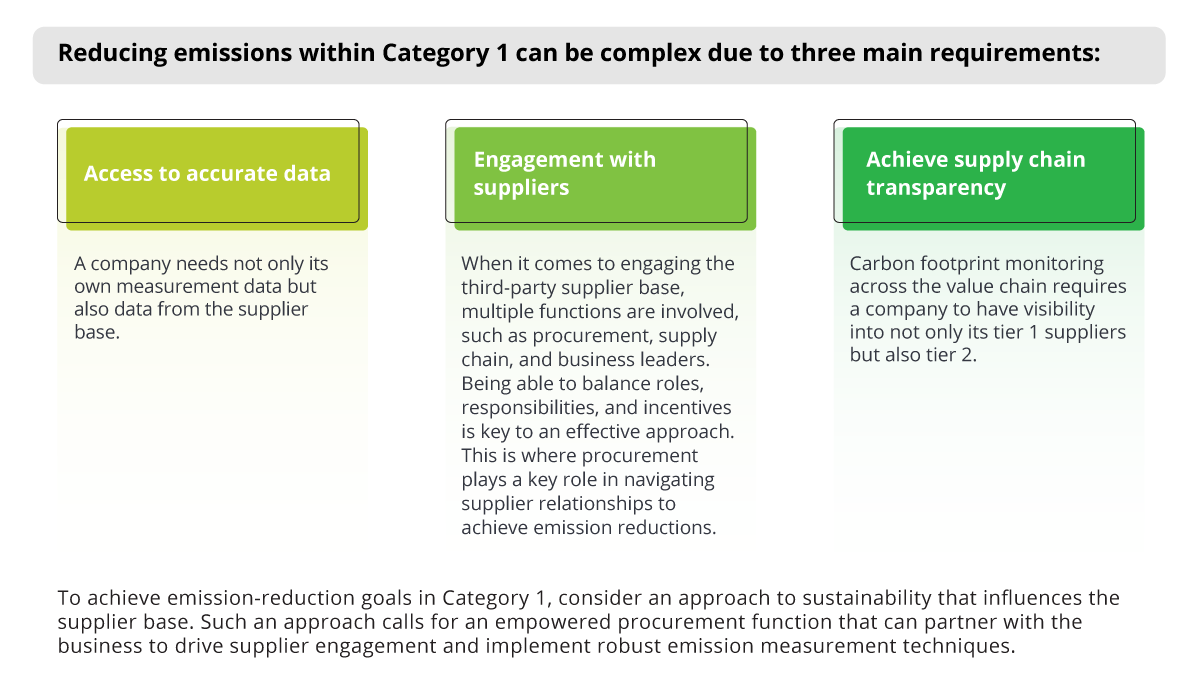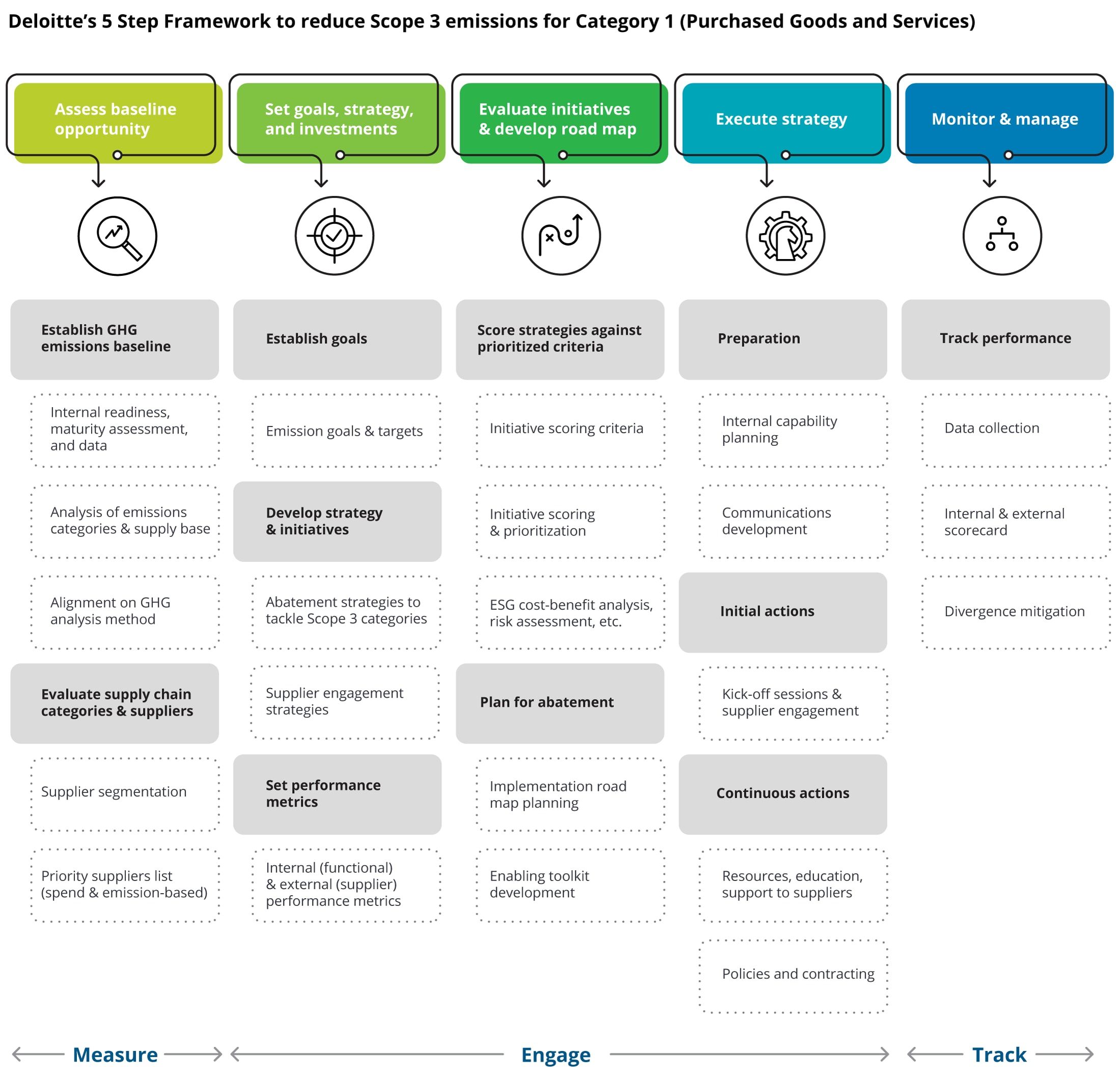Tackle Scope 3 emissions for supplier sustainability has been saved

Perspectives
Tackle Scope 3 emissions for supplier sustainability
Procurement’s role in reaching ESG goals
Companies with net-zero strategies see the urgent need to address Scope 3 emissions—often the largest portion of their carbon footprints. Procurement organizations play a crucial role in achieving emissions reductions and meeting the company’s ESG commitments.
Sustainability across the value chain: A 5-stage plan to address Scope 3
Scope 1 and 2 emissions are currently the “elephant in the room” of many boardrooms. The “mouse in the corner,” however, is Scope 3 emissions, or those that are an indirect result of the company’s value chain—and that mouse is growing larger. The growing concern over supply chain emissions is reflected in the evolving priorities of chief procurement officers (CPOs). According to Deloitte’s 2023 CPO Survey, environmental, social, and governance (ESG) has become the second-most important objective for CPOs, moving up from sixth place in 2021 (improving operational efficiency remains number one).
Why are Scope 3 emissions important to my organization’s sustainability goals?
Scope 3 emissions are often responsible for the largest proportion of a company’s carbon footprint. However, organizations that have a blueprint to net-zero and establish science-based targets (SBTs) are in need of a methodical, systematic, and impactful way to approach Scope 3 emissions, especially for Category 1, Purchased Goods and Services. This is the largest Scope 3 emissions category for most industries and the most complex, as it entails engaging with the supplier base. Procurement has a unique role in influencing one of the largest contributors of emissions.
While various companies and regulatory bodies have come up with abatement strategies for each category, Category 1, Purchased Goods and Services, still needs attention. Of 15 categories, it generally accounts for most Scope 3 emissions. The emission portion of this category ranges between 35% and 40%, depending on the industry, according to the Carbon Disclosure Project (CDP). This category alone can move the needle on sustainability efforts—but it requires a deliberate approach that accounts for multiple factors.

The 5-stage sustainability journey to reduce Scope 3 emissions for Category 1
Many companies have set net-zero targets using the Science Based Targets initiative (SBTi) that requires the inclusion of Scope 3 emissions but find it a challenge to create and execute a road map. Our approach interweaves the key components necessary to building it out.
As a starting point, assess your baseline emissions. Then, prioritize the emissions and supply categories they will focus on. This sets you up to start setting goals at the overall company level that will then need to be broken down at the emissions category and supplier level.
While establishing goals is a great first step, achieving them cannot be done with the flip of a switch. It is a journey that requires a strategy, a plan, and the ability to execute, including resource bandwidth, internal capabilities, and intercompany alignment. A good strategy takes into consideration how and at what level you will engage with your supplier base and the best carbon abatement programs given the finite resources available and suppliers’ context. When building the strategy, take a look at your own capabilities, too. Do you have the right knowledge within your organization to not only build out the strategy but connect the dots that will allow you to execute and manage the plan? Last but not least, you will have to manage and monitor both your suppliers’ performance against commitments and internal performance against strategy targets.
How does an organization go about reducing Scope 3 emissions, specifically in Category 1?
After carefully examining the approaches of multiple companies to Scope 3, Category 1, collecting information from CPOs, and looking at studies from prominent academic institutions, we designed a five-stage journey that aims to drive efficiency while speeding value impact:
- Assess baseline opportunity
- Set goals, strategy, and investments
- Evaluate initiatives and develop road map
- Execute strategy
- Monitor and manage

Spotlight:
|
Companies often struggle with deciding on requirements to put on their suppliers as well as with holding them accountable. To this end, Salesforce takes a firm leadership stance with suppliers, taking actions that show commitment to reducing Scope 3 emissions through procurement. The Salesforce Sustainability Exhibit in its contractual agreements with suppliers makes this evident. The exhibit articulates a clear, straightforward set of expected outcomes: suppliers set their own SBTs, deliver carbon-neutral products and services, and report their greenhouse gas emissions, with consequences for noncompliance. Salesforce not only holds its suppliers accountable, but also itself by linking its own executive compensation to sustainability goals and through its clear commitment to increase spend with sustainable suppliers. |
Explore the 5-stage plan to reach your sustainability
goals via Scope 3 in detail with the full report.
Contact us
Ready to navigate your path to net-zero? Let’s discuss how you can improve the collection and management of ESG data, influence change, and make sustainable progress.
Fill out your contact information below to get in touch with our team.
|
|
|
Recommendations
Increase organizational efficiency with sustainable transportation
Discover how net-zero emission goals are not only good for the environment but how that can improve your organizations bottom line with advanced TMS.





